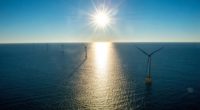Three offshore-wind developers that are competing to build the first U.S. utility-scale offshore wind farm, south of Martha’s Vineyard, have targeted Massachusetts as a hub to build a critical domestic contractor supply chain. Not to be outdone, Maryland also is pushing itself as a base for the emerging energy sector, approving two projects last month and rehabbing a former steelmaking site to host offshore-wind manufacturing and staging.
“We need long-term, flexible and creative partners,” said Jeff Grybowski, CEO of Deepwater Wind, developer of the first U.S. offshore-wind project, a 30-MW facility that began full operation off Rhode Island on May 1. He and others spoke on May 31 at a Newton, Mass., supply-chain matchmaking event for power suppliers, engineers, steel fabricators and marine services providers. It occurred the same day that New England’s last major coal-fired power plant, sited in Somerset, Mass., prepared to shut down, foreshadowing the state’s long-term commitment to clean energy.
Despite the Trump administration’s pro-fossil-fuel policy and a soon-to-be-released U.S. Energy Dept. study that will review the impacts of renewable-energy subsidies on power competition and grid stability, forum attendees were upbeat.
Said one meeting speaker, Roy Francis, senior vice president at Gulf Island Fabrication, “No matter what administration is in power, as old power plants go offline, the will of the people and the need for new sources of energy for communities will determine whether to go forward with offshore wind.”
The three developers, including two European-led ventures, await a final state request for proposals on June 30, stemming from its 2016 mandate to procure up to 1,600 MW of offshore wind by 2027. The state is developing major offshore-wind R&D, manufacturing and staging centers in Charlestown and New Bedford. Massachusetts Sen. Ed Markey (D) in May introduced a bill to extend by six years an offshore-wind investment tax credit now set to expire in 2019. Its prospects are unclear.
Dong Energy North America executive Fred Zalcman said the Danish firm’s unit seeks to engage supply-chain partners to become “a cookie-cutter operation” to achieve standardization and replicability. Eric Stephens, CEO of Denmark-linked offshore-wind site leaseholder Vineyard Wind, said if price was the only factor, it would lean heavily on European expertise. “But we’re in for the long term,” he said.
Vineyard announced in May it was teaming with Avangrid Renewables, which purchased 50% ownership in the Massachusetts project. Avangrid is owned by Spain-based Iberdrola, whiich also owns Scottish Power, a strong European offshore wind player. Iberdrola has a large onshore wind business and transmission development company in the U.S., Stephens said.
Eric Fine, business development manager for Smulders, a Belgium steel fabricator that builds foundations and substations, said he was “investigating whether the U.S. market could add [business] value. “Our [16-year-old European] fabrication technology is mature, so we think now is time to export our technology.”
Maryland got a jump with the surprise May 11 OK of both proposed projects, set to cost about $2.1 billion total; it is the largest such state action to date. Participants have agreed to conditions that include more than $100-million in port and infrastructure upgrades.
Baltimore County also applied for a $26-million federal grant in May to support infrastructure upgrades at the former Sparrows Point site.
“Maryland appears to be more serious about building supply chain in their state,” says a manager at one U.S.-based offshore-wind project contender. “We won’t know Massachusetts’ terms until they release the RFP.”
But he adds: "There’s no way to get this done without European equipment at first. They’ve already invested incredible amounts of money in turbine manufacturing facilities and installation vessels. Long term we hope to see domestic equipment, but not at the expense of progress."







Post a comment to this article
Report Abusive Comment